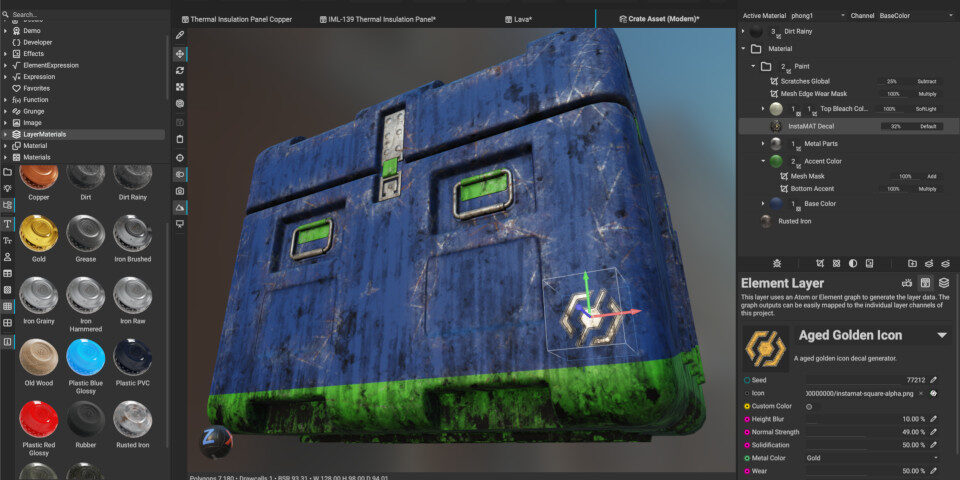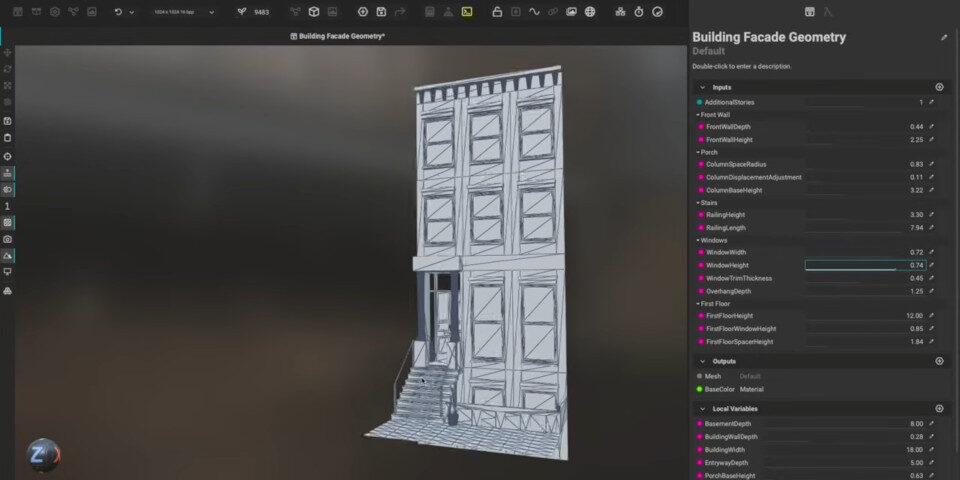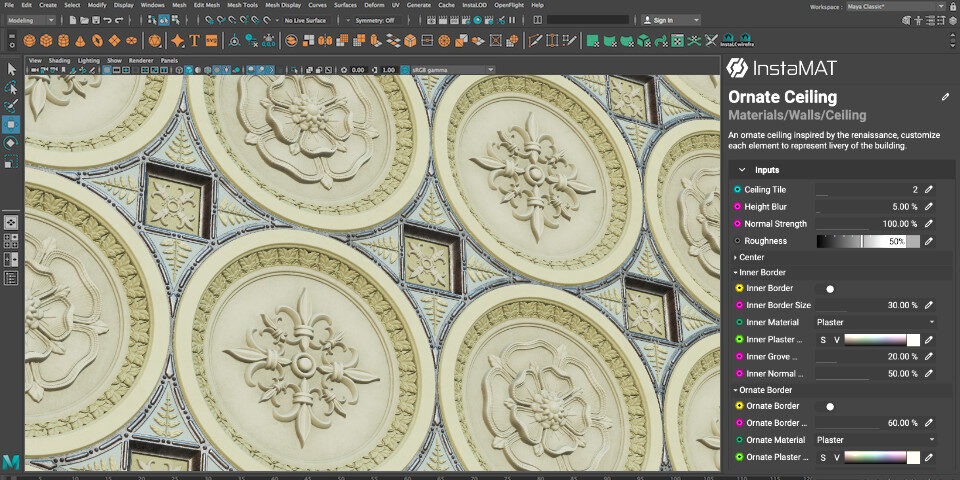InstaMAT Studio is now available
Games middleware developer Abstract has launched InstaMAT, a promising new family of 3D texture painting and material authoring tools along the lines of Adobe’s Substance 3D products.
The core application, InstaMAT Studio, supports layer-based painting and node-based authoring workflows similar to Substance 3D Painter and Substance 3D Designer, and includes AI-based features similar to those in Substance 3D Sampler.
Integration plugins make it possible to edit the procedural materials it creates inside a range of DCC applications and game engines: 3ds Max, Blender, Maya, Unity and Unreal Engine.
For studios, InstaMAT Pipeline makes it possible to run tasks from the command line, or batch-process assets; while a C++ SDK makes it possible to customize the software.
The tools got a lot of attention on CG community websites when they were announced earlier this month, among artists working in motion graphics and VFX as well as game development.
And, as of yesterday, they are now available in early access, with artists earning under $100.000/year able to use InstaMAT Studio for free, including on commercial projects.
From the developers of the popular InstaLOD mesh optimization system
Abstract has a proven track record, particularly in the games industry, being best known for developing mesh optimization technology InstaLOD.
As well AAA game development, it is used in visual effects and industrial design work, and is integrated into DCC applications including Reallusion’s Character Creator.
InstaMAT is the second of Abstract’s technologies to become publicly available, and, according to the initial product announcement, is the result of over five years of development.
Author procedural materials using a drag-and-drop node-based workflow
The core functionality of InstaMAT Studio will be familiar to users of the Substance 3D tools – a comparison that Abstract makes explicit in videos like the one above.
It combines features available in several Substance 3D tools, including Substance 3D Designer-style node-based material authoring and Substance 3D Painter-style 3D texture painting.
For material authoring, InstaMAT’s Canvas interface makes it possible to create procedural materials by wiring nodes together, and includes quality-of-life features like fuzzy search.
The software ships with a library consisting of “thousands” of nodes, including “over 1,000 AAA-quality” readymade materials created by Abstract’s in-house artists.
Users can also author custom functions for use within nodes, or even entire custom nodes.

Paint directly onto 3D assets in the viewport
Artists can also paint directly onto 3D models in the viewport in real time.
The painting toolset is layer-based, and includes masks, filters for non-destructive image adjustments, and generators for creating procedural noise.
It supports UDIM workflows, and mesh-based texture maps can be baked on CPU or GPU.
Users can instance one layer-based material within another, with changes made to the nested material automatically being propagated back to the source material.
It is even possible to mix and match workflows: dragging a node-based material onto a layer-based project automatically exposes the constituent layers, while dragging a layer-based project onto a node-based material automatically converts it to a node within the graph.
AI-based tools for generating and editing materials
In addition, InstaMAT Studio provides AI-based features for generating and processing textures.
Its Materialize Image system generates a set of PBR texture maps from a single source photo, along the lines of Substance 3D Sampler’s Image to Material feature.
The online documentation is still a work in progress, but other presumably-AI-trained features shown in the launch video include texture upscaling; style transfer between textures; and even synthesis of entire new textures, with support for inpainting.

Processes 3D geometry and point clouds as well as materials
As well as materials, InstaMAT Studio can generate 3D geometry: the software includes a procedural modeling toolset – a feature that has been removed from Substance 3D Designer.
The software’s Element Graph can also process point cloud data, with the launch video showing a data synthesis feature for regenerating areas of a raw 3D scan.

Designed to integrate into studio production pipelines
InstaMAT Studio is part of a wider ecosystem of tools, with integration plugins making it possible to edit the materials it creates directly inside 3ds Max, Blender, Maya, Unity and Unreal Engine.
For users with commercial subscriptions, a separate application, InstaMAT Pipeline, makes it possible to execute InstaMAT Studio graphs from the command line: for example, to automate unit tests or tasks like baking mesh data.
And for pipeline integration, the software comes with a C++ SDK.
Available free, for commercial use, with some restrictions
It’s still too early to tell how the InstaMAT tools will perform in production, and the examples shown in the demo videos are fairly simple: individual hard-surface assets and small 3D scans.
However, if you want to try before you buy, Abstract offers free Pioneer licenses, which include InstaMAT Studio and the software integration plugins, but not InstaMAT Pipeline or the C++ SDK.
They can be used for commercial work if you earn under $100,000/year, although not to do freelance work for other companies with annual revenues over that threshold.
Updated 26 January: Abstract tells us that it has updated its license terms to permit freelance work for larger companies.
In addition, any product you create using InstaMAT must credit the software when released publicly: on the splash screen, it it’s a game, or on the webpage if it’s online content.
Pioneer licenses are renewable one-year licenses, and you have to agree to share your user data with Abstract when you install the software.
Price and system requirements
InstaMAT Studio is compatible with Windows 7+, Windows Server 2016+ and macOS 13.0+. Integration plugins are available for 3ds Max, Blender, Maya, Unity and Unreal Engine.
The Pioneer edition of the software is available free to artists and studios with revenue under $100,000/year, and can be used on commercial projects, with the restrictions above.
For users with revenuue under $250,000/year, perpetual licenses cost $489.99, while rental costs $9.99/month or $109.99/year.
For users with revenue over $250,000/year, perpetual liencses cost $949.99, while rental costs $24.99/month or $274.99/year.
Abstract also offers studio-wide Game and Enterprise licenses. See full pricing here.
Visit the InstaMAT product website
Read more about the InstaMAT tools in the online documentation
Get started using the InstaMAT tools with Abstract’s video tutorials
Have your say on this story by following CG Channel on Facebook, Instagram and X (formerly Twitter). As well as being able to comment on stories, followers of our social media accounts can see videos we don’t post on the site itself, including making-ofs for the latest VFX movies, animations, games cinematics and motion graphics projects.
